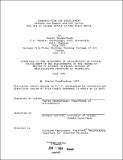Communication and development : between the hammer and the mirror, the use of cinema verite in the Third World
Author(s)
Shankardass, Sharad
DownloadFull printable version (2.120Mb)
Alternative title
When movies were movies
Cinema verite in the Third World
Other Contributors
Massachusetts Institute of Technology. Dept. of Architecture.
Advisor
Richard Leacock.
Terms of use
Metadata
Show full item recordAbstract
This thesis is essentially about the role and use of cinema verite in development communications. The central argument is that in the diffusion of this method of filmmaking to developing countries, the technology was separated from the philosophy. Briefly, it is argued that whereas the technology was readily adopted, the philosophy was rejected for a number of reasons. Chief amongst these is that under the major development paradigms of the first two decades after independence, industrialization and state centralization, the media were used to "hammer" the myths of modernization. In such a context, an aesthetic like cinema verite, which is committed to revelation and "mirroring" people as they are, was bound to have difficulties in being adopted. However, it is the contention of this thesis that, with the recent crisis in development theory and the development of the newer lightweight video technologies, cinema verite can provide a useful and necessary model. Recent theories of development stress the need for rural development and decentralization. In such a context, the role of media becomes one of encouraging participation by mirroring the concerns of the rural population. It is argued that cinema verite offers distinct possibilities. A videotape production is offered with the thesis. "When Movies Were Movies" was made using the simplest of video technologies. Though the videotape is not directly related to the area of development communications, it was the intention to use the videotape as a way of providing the author with experience in the production of observational film using the newer video technologies. The video production is supposed to work at three levels. It is an observation of the dilemmas of the Indian minorities of East Africa caught in the problems of assimilating into Canadian culture. It is also about the role played by media in shaping our perceptions. Finally, it is about the changes in technology which affect the very presentation of everyday life.
Description
Thesis (M.S.V.S.)--Massachusetts Institute of Technology, Dept. of Architecture, 1984. MICROFICHE COPY AVAILABLE IN ARCHIVES AND ROTCH Includes bibliographical references (leaves 46-48).
Date issued
1984Department
Massachusetts Institute of Technology. Department of ArchitecturePublisher
Massachusetts Institute of Technology
Keywords
Architecture.